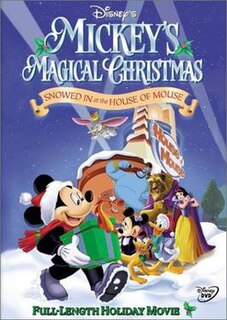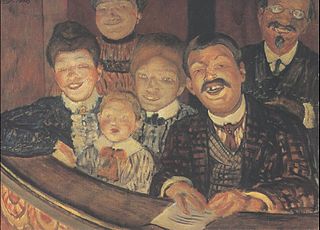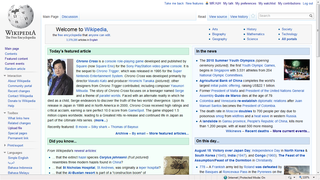This article needs additional citations for verification .(February 2019) (Learn how and when to remove this template message) |
| House of Mouse | |
|---|---|
 Mickey Mouse and his friends run the House of Mouse nightclub together. | |
| Created by |
|
| Based on | Characters by Walt Disney Animation Studios |
| Directed by |
|
| Presented by | Wayne Allwine |
| Voices of | |
| Narrated by | Rod Roddy |
| Theme music composer | Brian Setzer |
| Country of origin | United States |
| No. of seasons | 3 |
| No. of episodes | 52 (list of episodes) |
| Production | |
| Running time | 20 minutes (Shorts 10 minutes approx.) |
| Production company(s) | Walt Disney Television Animation |
| Distributor | Buena Vista Television |
| Release | |
| Original network |
|
| Picture format | |
| Audio format | Stereo |
| Original release | January 13, 2001 – October 24, 2003 |
| External links | |
| Website | |
Disney's House of Mouse or simply House of Mouse is an American animated television series, produced by Walt Disney Television Animation (now Disney Television Animation), that originally aired for three seasons from 13 January 2001, to its finale on 24 October 2003. The show focuses on Mickey Mouse and his friends running a cartoon theater dinner club in the fictional ToonTown, catering to many characters from Disney cartoons and animated movies while showcasing a variety of their cartoon shorts. The animated series is a spin off of the popular short-lived Disney series Mickey Mouse Works , and featured many Mouse Works shorts as well as selection of brand new shorts; classic Mickey Mouse, Goofy and Donald Duck shorts from the 1930s–50s were also occasionally seen, particularly towards the end of the series' run when the finite amount of Mouse Works shorts had almost been exhausted.

Animation is a method in which pictures are manipulated to appear as moving images. In traditional animation, images are drawn or painted by hand on transparent celluloid sheets to be photographed and exhibited on film. Today, most animations are made with computer-generated imagery (CGI). Computer animation can be very detailed 3D animation, while 2D computer animation can be used for stylistic reasons, low bandwidth or faster real-time renderings. Other common animation methods apply a stop motion technique to two and three-dimensional objects like paper cutouts, puppets or clay figures.

Disney Television Animation (DTVA) is an American animation studio that creates, develops and produces animated television series, films, specials and other projects. It is a division of the Disney Channels Worldwide, ultimately owned by The Walt Disney Company.

Mickey Mouse is a funny animal cartoon character and the mascot of The Walt Disney Company. He was created by Walt Disney and Ub Iwerks at the Walt Disney Studios in 1928. An anthropomorphic mouse who typically wears red shorts, large yellow shoes, and white gloves, Mickey is one of the world's most recognizable characters.
Contents
During its time, the animated series held two nominations for awards, while select cast members won two awards for their performances as characters in House of Mouse. The series featured two special films – Mickey's Magical Christmas: Snowed in at the House of Mouse and Mickey's House of Villains – along with an all-night marathon of the House of Mouse, aired on Toon Disney in September 2002 under the title "Night of 1,000 Toons".

Mickey's Magical Christmas: Snowed in at the House of Mouse is a 2001 American direct-to-video animated film produced by Walt Disney Television Animation, with the animation production being done at Toon City Animation in Manila, Philippines. It is the first of two direct-to-video films spin off from the Disney Channel animated television series Disney's House of Mouse. The events of the film take place during the second season of Disney's House of Mouse.

Mickey's House of Villains is a 2002 direct-to-video animated film produced by Walt Disney Television Animation. It is based on the animated television series, Disney's House of Mouse and a sequel to the direct-to-video animated film Mickey's Magical Christmas: Snowed in at the House of Mouse, starring Mickey Mouse, Donald Duck, Minnie Mouse, Goofy, Daisy Duck and Disney Villains that have appeared in past Disney productions. It was released on both VHS and DVD by Walt Disney Home Entertainment on September 3, 2002. It was followed by a 2004 direct-to-video animated film, Mickey, Donald, Goofy: The Three Musketeers and Mickey's Twice Upon a Christmas, produced by DisneyToon Studios. The events of the film take place during the third and final season of Disney's House of Mouse.

Toon Disney was an international pay television channel which was owned by the Disney Channels Worldwide, a subsidiary of Disney–ABC Television Group. A spin-off of the Disney Channel, the channel mostly aired children's animated series and some live action programming. Its format had similarities to those of Discovery Kids, Cartoon Network, and Nicktoons. The channel's target audience was children ages 2–12, and children ages 7–14 during its nighttime block called Jetix. The US version of Toon Disney shut down on February 13, 2009, after nearly 11 years, and was succeeded by Disney XD, which has carried some programs previously seen on Toon Disney. The final channel bearing the Toon Disney moniker was in Italy, and was discontinued in 2011.

















